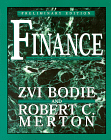Robert C. Merton (1944-)
Premio Nobel  1997
1997
Economista estadounidense, profesor en la Harvard University de Massachussets, obtuvo el Premio Nobel de economÃa en 1997, compartido con Myron S. Scholes por desarrollar un nuevo método para determinar el valor de los derivados.

OBRAS
"A Complete Model of Warrant Pricing that Maximizes Utility", with P.A. Samuelson, 1969, Industrial Management Review
"Lifetime Portfolio Selection under Uncertainty: The continuous time case", 1969, REStat
"Optimum Consumption and Portfolio Rules in a Continuous Time Model", 1971, JET
"An Analytic Derivation of the Efficient Portfolio Frontier", 1972, J of Financial and Quantitative Analysis
"An Intertemporal Capital Asset Pricing Model", 1973, Econometrica
"Theory of Rational Option Pricing", 1973, Bell JE
"On the Pricing of Corporate Debt: the risk structure of interest rates", 1974, J of Finance
"The Fallacy of the Log-Normal Approximation to Optimal Portfolio Decision Making Over Many Periods", with P.A. Samuelson, 1974, J of Financial Econ
"An Asymptotic Theory of Growth under Uncertainty", 1975, RES
"Theory of Finance from the Perspective of Continuous Time", 1975, J of Financial and Quantit Analysis
"Option Pricing when the Underlying Stock Returns are Discontinuous", 1976, J of Financial Econ
"On the Pricing of Contingent Claims and the Modigliani-Miller Theorem", 1977, J of Financial Econ
"A Re-Examination of the Capital Asset Pricing Model", 1977, in Friend and Bicksler, editors, Studies in Risk and Return
"On the Cost of Deposit Insurance when there are Surveillance Costs", 1978, J of Business
"On Estimating Expected Returns on the Market: An exploratory investigation", 1980, J of Financial Econ
"On the Microeconomic Theory of Investment and Certainty", 1982, in Arrow and Intriligator, editors, Handbook of Mathematical Economics: Vol. 2.
"On the Mathematics and Economics Assumptions of Continuous- Time Financial Models", 1982, in Sharpe and Cootner, editors, Financial Economics
"Variance Bounds in a Simple Model of Asset Pricing", 1982, JPE
"Dividend Variability and Variance Bounds Tests for the Rationality of Stock Market Prices", with T. Marsh, 1986, AER
"A Simple Model of Capital Market Equilibrium with Incomplete Information", 1987, J of Finance
"On the Current State of the Stock Market Rationality Hypothesis", 1987, in Fisher, Dornbush and Bossons, editors, Macroeconomics and Finance
"On the Application of Continuous-Time Theory of Finance to Financial Intermediation and Insurance", 1989, Papers on Risk and Insurance
Continuous Time Finance, 1990.
Si está conectado a Internet, puede adquirir los siguientes libros:
 Finance
Finance
por Zvi Bodie y Robert C. Merton
Este curso introductorio, de fácil lectura, permite entender los principios generales de las finanzas. Tres son los pilares básicos del análisis: la optimización a lo largo del tiempo, la valoración de los activos y la gestión del riesgo. En el núcleo de estos pilares hay unas pocas leyes y principios básicos que deben regir todos los procesos de adopción de decisiones financieras tanto a nivel personal como corporativo sobre ahorro, inversión y préstamo.
Continuous-Time
Finance por Robert C. Merton
Es una colección de artÃculos de Merton publicados entre los 70 y los 90. El
enfoque del "tiempo contÃnuo" fue introducido por Robert Merton como
método de valoración financiera. En estos artÃculos se describen las
mátemáticas básicas necesarias para este tipo de valoraciones, para la
selección de carteras, precios de opciones y la teorÃa del equilibrio
intertemporal.



| En eumed.net: |
 1647 - Investigaciones socioambientales, educativas y humanísticas para el medio rural Por: Miguel Ángel Sámano Rentería y Ramón Rivera Espinosa. (Coordinadores) Este libro es producto del trabajo desarrollado por un grupo interdisciplinario de investigadores integrantes del Instituto de Investigaciones Socioambientales, Educativas y Humanísticas para el Medio Rural (IISEHMER). Libro gratis |
15 al 28 de febrero |
|
| Desafíos de las empresas del siglo XXI | |
15 al 29 de marzo |
|
| La Educación en el siglo XXI | |




